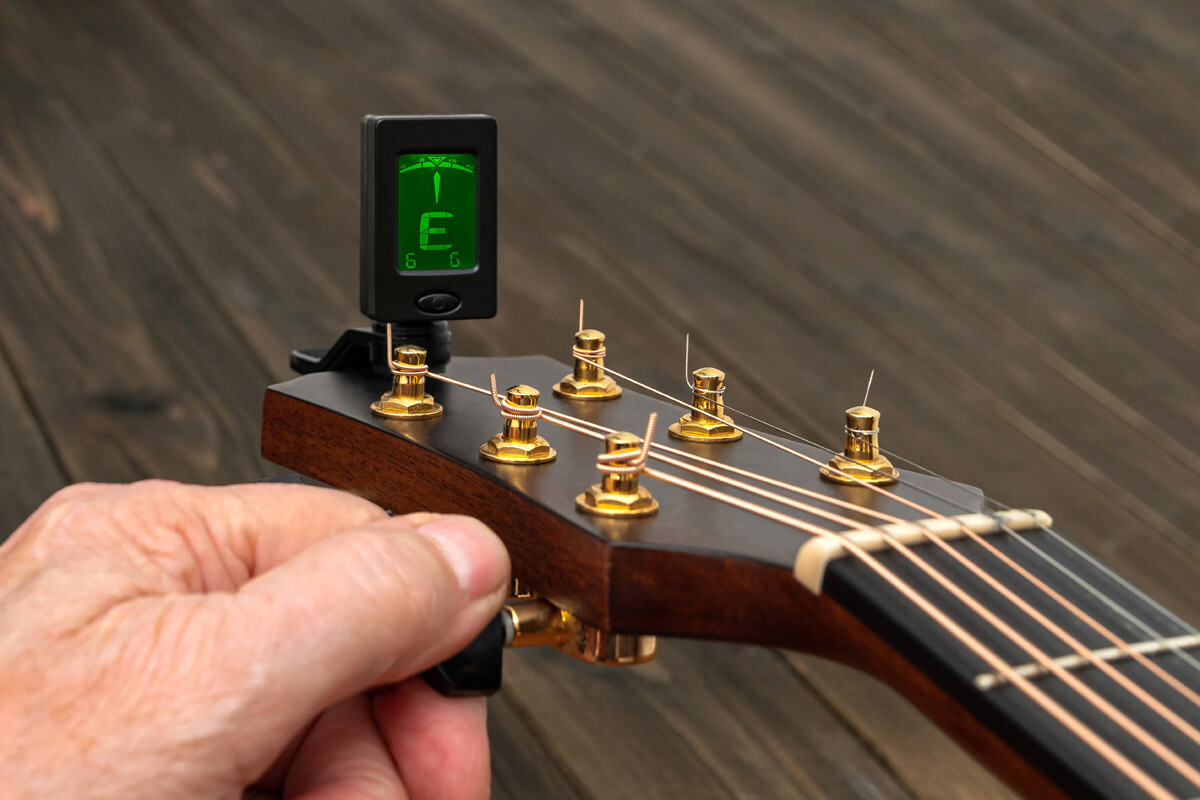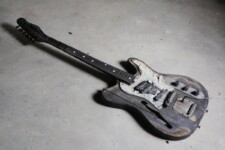Guitar Won’t Stay in Tune? (Here’s Why)
If you’re a guitar player, you know how frustrating it can be when your guitar won’t stay in tune. You spend more time tuning than playing, and your songs just don’t sound right. You may wonder what’s wrong with your guitar or your strings, and how you can fix it.
The truth is, there are many possible reasons why your guitar won’t stay in tune. Some of them are easy to fix, while others may require professional help. In this article, we’ll explain some of the most common causes of tuning problems and how you can solve them.

We’ll also give you some tips on how to keep your guitar in tune longer and avoid tuning issues in the future. By the end of this article, you’ll have a better understanding of why your guitar won’t stay in tune and what you can do about it.
Old or New Strings
One of the most obvious reasons why your guitar won’t stay in tune is because of your strings. Strings are constantly under tension and wear out over time. They lose their elasticity and ability to hold pitch. They also accumulate dirt, oil, sweat, and corrosion that affect their tone and tuning stability.
If your strings are old or worn out, they may go out of tune easily or sound dull and lifeless. The solution is simple: change your strings regularly. Depending on how often you play and how you care for your strings, you may need to change them every few weeks or months.
On the other hand, if your strings are new or freshly installed, they may also go out of tune quickly. This is because they need time to stretch and settle on your guitar. They may also slip at the bridge or the tuning pegs until they are properly seated.
If your strings are new or freshly installed, you need to stretch them manually before playing. This will help them stabilize faster and stay in tune longer.
To stretch your strings, follow these steps:
- Tune your strings to pitch.
- Place your index and middle fingers underneath the string at the 12th fret and pull upwards.
- Retune your string to pitch (it will likely go flat).
- Repeat the process at different frets along the string.
- Repeat the entire process for each string.
You can also watch this video tutorial by Sammy Bones on YouTube for more guidance:
Improper String Installation
Another reason why your guitar won’t stay in tune is because of improper string installation. If you don’t wrap your strings correctly around the tuning pegs or secure them properly at the bridge, they may slip or move when you play. This will cause them to lose tension and go out of tune.
To install your strings correctly, follow these steps:
- Thread the string through the bridge saddle and pull it tight
- Thread the string through the tuning peg hole and leave some slack
- Bend the string at a right angle away from the tuning peg
- Wrap the string around the tuning peg counter-clockwise (for standard tuners)
- Make sure that each wrap goes below the previous one
- Cut off any excess string
Nut or Tuning Peg Issues
The nut and the tuning pegs are two of the most important parts of your guitar that affect its tuning. The nut is the piece of bone or plastic that holds the strings at the headstock. The tuning pegs are the knobs that you turn to adjust the pitch of the strings.
If the nut or the tuning pegs are damaged, worn, or poorly adjusted, they may cause your guitar to go out of tune. Some of the common issues are:
- The nut slots are too narrow or too wide for the strings. This may pinch or slip the strings and affect their tension and intonation.
- The nut is not lubricated properly. This may cause friction and prevent the strings from returning to their original pitch after bending or using a tremolo system.
- The tuning pegs are loose or faulty. This may cause the strings to slip or unwind and lose their pitch.
To fix these issues, you may need to:
- File or widen the nut slots to fit the strings. This should be done by a professional luthier or technician to avoid damaging the nut or affecting the action and intonation of your guitar.
- Lubricate the nut slots with graphite, pencil lead, or a special product like Big Bends Nut Sauce. This will reduce friction and allow the strings to move smoothly and stay in tune.
- Tighten or replace the tuning pegs. This will prevent the strings from slipping or unwinding and keep them stable.
Tremolo System or Truss Rod Issues
The tremolo system and the truss rod are two of the most complex and delicate parts of your guitar that affect its tuning. The tremolo system is a device that allows you to change the pitch of the strings by moving a lever or a bar. The truss rod is a metal rod that runs inside the neck and allows you to adjust its curvature and relief.
If the tremolo system or the truss rod are not set up properly, they may cause your guitar to go out of tune. Some of the common issues are:
- The tremolo system is not balanced with the string tension. This may cause the bridge to tilt forward or backward and affect the action and intonation of your guitar.
- The tremolo system is not locked or stabilized. This may cause the strings to go out of tune when you use the tremolo bar or bend notes.
- The truss rod is too tight or too loose. This may cause the neck to bow or twist and affect the action and intonation of your guitar.
To fix these issues, you may need to:
- Balance the tremolo system with the string tension. This can be done by adjusting the springs in the back cavity of your guitar until the bridge is parallel to the body.
- Lock or stabilize the tremolo system. This can be done by using a locking nut, locking tuners, or a device like Tremol-No that prevents the bridge from moving.
- Adjust the truss rod with an allen wrench. This can be done by turning it clockwise to tighten it or counter-clockwise to loosen it until you achieve a slight relief in your neck.
These adjustments are very sensitive and can affect your guitar’s playability and sound. Therefore, they should be done by a professional luthier or technician or with extreme caution and care.
Poor Intonation or Tuning Technique
The intonation and tuning technique are two of the most basic and essential aspects of your guitar that affect its tuning. The intonation is how well your guitar plays in tune across all frets and strings. The tuning technique is how you use your tuner or your ear to set the pitch of each string.
If your intonation or tuning technique are poor, they may cause your guitar to go out of tune. Some of the common issues are:
- Your intonation is off. This means that your guitar plays in tune at some frets but not at others. This can be caused by improper string installation, string gauge, action, bridge position, nut height, fret wear, etc.
- You are not tuning up to pitch. This means that you are lowering your string’s pitch until it matches your tuner instead of raising it. This can cause slack in your string and make it go flat when you play.
- You are not using a reliable tuner. This means that you are using a tuner that is inaccurate, out-of-date, poorly calibrated, or affected by background noise. This can cause you to tune your guitar incorrectly and make it sound out of tune.
To fix these issues, you may need to:
- Adjust your intonation with a screwdriver. This can be done by moving each bridge saddle forward or backward until each string plays in tune at both open position and 12th fret.
- Tune up to pitch with a tuner or your ear. This can be done by raising your string’s pitch slightly above your tuner’s indication and then lowering it until it matches it.
- Use a reliable tuner that is accurate, up-to-date, well-calibrated, and unaffected by background noise. You can use a clip-on tuner, a pedal tuner, an app tuner
Humidity and Temperature Changes
The humidity and temperature are two of the most external and environmental factors that affect your guitar’s tuning. The humidity and temperature affect the wood and metal components of your guitar, causing them to expand or contract. This affects the string tension and length, which affects the pitch.
If the humidity or temperature changes drastically, they may cause your guitar to go out of tune. Some of the common issues are:
- The humidity is too high or too low. This may cause the wood to swell or shrink, affecting the neck relief, action, and intonation of your guitar.
- The temperature is too high or too low. This may cause the metal to expand or contract, affecting the string tension, length, and pitch of your guitar.
To fix these issues, you may need to:
- Control the humidity and temperature levels around your guitar. This can be done by using a humidifier or dehumidifier, a heater or cooler, or a case with a hygrometer and thermometer.
- Adjust your guitar to the humidity and temperature changes. This can be done by tuning your guitar more frequently, using a truss rod adjustment, or using a bridge adjustment.
Using a Capo
A capo is a device that clamps onto the neck of your guitar and shortens the length of the strings. This allows you to play in different keys without changing your fingerings or chords. A capo can be a useful tool for playing songs that are otherwise difficult or impossible to play on your guitar.
However, using a capo can also affect your guitar’s tuning. Some of the common issues are:
- The capo is too tight or too loose. This may cause the strings to be pulled out of tune or slip out of place.
- The capo is not placed correctly. This may cause the strings to be pressed down unevenly or buzz against the frets.
To fix these issues, you may need to:
- Adjust the capo’s tension and position. This can be done by using a capo that has an adjustable screw or clamp, or by moving the capo slightly up or down on the fretboard.
- Retune your guitar after using a capo. This can be done by using a tuner or your ear to check and correct each string’s pitch.
How to Keep Your Guitar in Tune Longer
Now that you know some of the reasons why your guitar won’t stay in tune and how to fix them, you may wonder how you can keep your guitar in tune longer and avoid tuning issues in the future. Here are some tips that can help you:
- Change your strings regularly and stretch them properly
- Install your strings correctly and securely
- Check and maintain your nut and tuning pegs
- Set up your tremolo system and truss rod properly
- Adjust your intonation and tune up to pitch
- Use a reliable tuner and tune your guitar frequently
- Control the humidity and temperature levels around your guitar
- Adjust your capo’s tension and position
- Retune your guitar after using a capo
By following these tips, you can improve your guitar’s tuning stability and enjoy playing it more. Remember, a well-tuned guitar sounds better, plays better, and makes you a better musician.
We hope this article has helped you understand why your guitar won’t stay in tune and what you can do about it. Happy playing!



